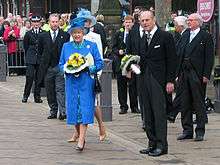Nosegay

A nosegay, posy, or tussie-mussie is a small flower bouquet, typically given as a gift. They have existed in some form since at least medieval times, when they were carried or worn around the head or bodice.[1] Doilies are traditionally used to bind the stems in these arrangements. Alternatively, "posy holders", available in a variety of shapes and materials (although often silver), enable the wearing of these arrangements "at the waist, in the hair, or secured with a brooch".[2]
The term nosegay arose in fifteenth-century Middle English as a combination of nose and gay (the latter then meaning "ornament"). So a nosegay was an ornament that appeals to the nose or nostril.[3]
The term tussie-mussie (also tussy-mussy) comes from the reign of Queen Victoria (1837–1901), when the small bouquets became a popular fashion accessory. Typically, tussie-mussies include floral symbolism from the language of flowers, and therefore may be used to send a message to the recipient.[4] In modern times the term specifically refers to small bouquets in a conical metal holder, or the holder itself, particularly when used at a white wedding.[5][6]
See also
References
- ↑ "Head Garlands and Nosegays". Yankee Peddler Festival. May 14, 2008.
- ↑ Felbinger, Elaine (May–June 2005). "Tussie Mussies". SUBROSA: The Huntington Rose and Perennial Gardens Newsletter. huntingtonbotanical.org (42). Retrieved 26 January 2014.
- ↑ "Word of the Day: nosegay". Merriam-Webster Online. December 25, 2010.
- ↑ Tussie-Mussies, the Victorian Art of Expressing Yourself in the Language of Flowers. Workman Publishing. 1993.
- ↑ "Tussy Mussy Wedding Bouquets".
- ↑ "Victorian Tussie Mussie, Bouquet With Meaning".
| Wikimedia Commons has media related to Flower bouquets. |
| Look up nosegay in Wiktionary, the free dictionary. |


